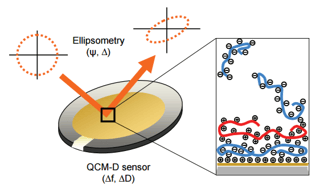Tips & Tricks When Combining Spectroscopic Ellipsometry
and QCM-D
[RECORDED WEBINAR]
Learn something new! Lots of practical advice tailored for QCM-D/SE users and those interested in the combinatorial technique.
 When it comes to quantifying adsorption, desorption, or surface reactions at the solid-liquid interface, quartz crystal microbalance with dissipation monitoring (QCM-D) and spectroscopic ellipsometry (SE) are kindred spirits. Both are real-time, label-free techniques. Both can report the thickness of adsorbate layers. But by using these two techniques together, one is able to learn about the swelling of a solvated adsorbate layer. Numerous systems including polymeric films, proteins, nucleic acids, nanoparticles, and surfactants have been studied with this combinatorial approach.
When it comes to quantifying adsorption, desorption, or surface reactions at the solid-liquid interface, quartz crystal microbalance with dissipation monitoring (QCM-D) and spectroscopic ellipsometry (SE) are kindred spirits. Both are real-time, label-free techniques. Both can report the thickness of adsorbate layers. But by using these two techniques together, one is able to learn about the swelling of a solvated adsorbate layer. Numerous systems including polymeric films, proteins, nucleic acids, nanoparticles, and surfactants have been studied with this combinatorial approach.
Most effort for a QCM-D/SE experiment is done before the data acquisition even starts, and at least three SE measurements should be taken as the experimental setup is being assembled.
This recorded webinar is filled with practical advice tailored for QCM-D/SE users and those interested in the combinatorial technique. Sign up!
Aired: March 7th, 2017 Duration: 30 min
 |
Speaker: Brian Rodenhausen, Ph.D. |